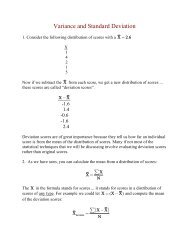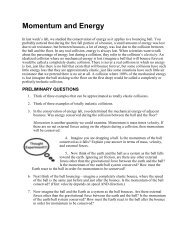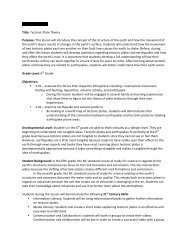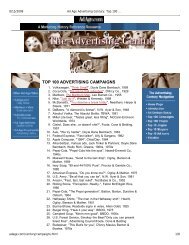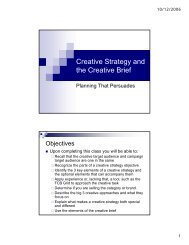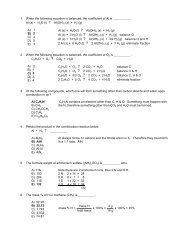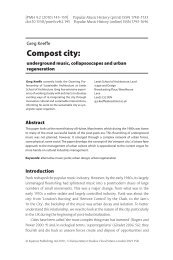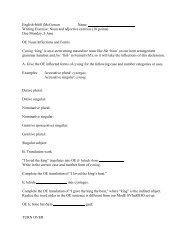Operant Conditioning I
Operant Conditioning I
Operant Conditioning I
You also want an ePaper? Increase the reach of your titles
YUMPU automatically turns print PDFs into web optimized ePapers that Google loves.
<strong>Operant</strong> vs. Pavlovian <strong>Conditioning</strong>• <strong>Operant</strong> responses understood by comprehending the consequences they produce• Pavlovian responses may have environmental effects, but this is not what controls themEdward Thorndike• Acquisition of Goal‐directed responses.• Consequences of a behavior can increase or decrease the future probability of that behaviorLaw of Effect• Responses followed by a satisfying outcome will strengthen the association between the situation andthe response.• Responses followed by a dissatisfying outcome will weaken the association between the situation andthe response.• The strength of the association between a situation and a response determines the probability of theresponse in that situation.• Law of Effect = S‐R learningDiscrete‐Trial Procedures• Discrete‐trial procedures provide animal with limited opportunities to respond.Free‐<strong>Operant</strong> Procedures• Free‐operant procedures allow the animal to repeat the instrumental response repeatedly withoutconstraint.<strong>Operant</strong> <strong>Conditioning</strong>• Free‐<strong>Operant</strong> Procedure• <strong>Operant</strong> Response ‐ behavior that animal performs• <strong>Operant</strong> Reinforcer ‐ an event that increases the probability of an operant response (e.g., food)
Training a new response• Magazine training ‐ must first teach animals that reinforcement is available in their environment• Present food periodically• Animal forms association between sound of food magazine and availability of foodShaping• Shaping through successive approximations• Reinforce behaviors that lead the animal closer to performing the desired response• Withhold reinforcement for earlier response formsTypes of Reinforcement• Primary reinforcement – a stimulus that is innately reinforcing• Secondary (Conditioned) reinforcement – a stimulus that is reinforcing through its association with areinforcerThree‐term contingency• AntecedentBehaviorConsequence• Antecedent = Discriminative stimulus• Behavior = Response• Consequence = Reinforcing Stimulus• e.g., notice somethingdo somethingget somethingTypes of Instrumental <strong>Conditioning</strong> Procedures• Reinforcement ‐ Increases probability of a response• Punishment ‐ Decreases probability of a response• Positive ‐ Response produces a stimulus• Negative ‐ Response removes a stimulus
Examples1. The word positive, when combined with the word reinforcement or punishment, means that thebehavior is followed by the _____ of something. The word negative when combined with the wordreinforcement or punishment, means that the behavior is followed by the _____ of something.2. The word positive, when combined with the word reinforcement or punishment, (does/does not) _____mean that the consequence is good or pleasant. Similarly, the word negative when combined with theword reinforcement or punishment, (does/does not) ______ mean that the consequence is bad orunpleasant.3. Within the context of reinforcement and punishment, positive refers to the (addition/subtraction) ____of something, whereas negative refers to the (addition/subtraction) ____ of something.4. Reinforcement is related to a(n) (increase/decrease) ____ in behavior, whereas punishment is related toa(n) (increase/decrease) ____ in behavior.5. When the dog sat at your feet and whined during breakfast one morning, you fed him. As a result, he satat your feet and whined during breakfast the next morning. The consequence for the dog’s whiningconsisted of the (presentation/removal) ____ of a stimulus, and his behavior of whining subsequently(increased/decreased) ____ in frequency; therefore, this is an example of ____.6. Karen cries while saying to her boyfriend, “John, I don’t feel that you love me anymore”. John givesKaren a hug saying “That’s not true, dear, I love you very much.” If John’s hug is a reinforcer, Karen is____ likely to cry the next time she feels insecure about her relationship. This is an example of _________ of Karen’s crying behavior.7. Turning down the heat because you are too hot is an example of _____ _____.8. When Sasha was teasing the dog, it bit her. As a result, she no longer teases the dog. The consequencefor Sasha’s behavior of teasing the dog was the (presentation/removal) ____ of a stimulus, and theteasing behavior subsequently (increased/decreased) _____ in frequency; therefore, this is an example of_____ ______.9. John’s girlfriend, who is quite jealous, completely ignores him when she observes him having aconversation with another women at a party. As a result, he stopped talking to the other women at theparty. This is an example of _____ _____.10. Jean has a headache and takes an aspirin. If the aspirin reduces her headache and she becomesmore likely to take aspirin in the future, then this is an example of ____ ____.11. Bob talks back to his boss and as a consequence is demoted. If Bob becomes less likely to talk back tohis boss as a consequence of this loss of pay and status, then this would be an example of _____ _____.
Factors Influencing Instrumental LearningReinforcer Magnitude• Crespi (1942) ‐ Examined effect of magnitude of reinforcement on running speed in a runway• Phase 1: Trained three groups of rats. Received either 1, 16, or 256 pellets at the end of the runway• Phase 2: All groups received 16 pellets• Anticipatory Contrast ‐• Explanation:• Running speed influenced by current reward magnitude and prior reward magnitude• Reinforcer magnitude increases rate of responding, but not necessarily rate of learningContrast Effects• Positive Contrast ‐ Increases in the magnitude of reward increases performance (above control levels)• Negative Contrast ‐ Decreases in the magnitude of reward decreases performance (below control levels)• Not the result of new learning or unlearning ‐ performance variableContiguity• Immediate reinforcement is more effective than delayed reinforcement– Failure to associate behavior with consequenceContingency• Superstitious BehaviorooSkinner ‐ chance reinforcement of an arbitrary responseOther views on Superstition• Staddon ‐ behaviors were not arbitraryoInterim and Terminal Behaviors• Misbehavior of Organisms• Terminal behaviors are species typical responses that occur in anticipation of food
Learned HelplessnessPhase 1Phase 2• Group E: Escapable Shock• Group I: Inescapable Shock• Group C: Receives No Shock• LightShock• Group I failed to learn to avoid shockLearned Helplessness Hypothesis• Animals learn that their responses are ineffective during Phase 1 (No correlation between response andoutcome)• Expect that responses will be ineffective in the futureCharacteristics of Learned Helplessness• Motivational Deficit ‐ failed to perform escape response during shock• Cognitive Deficit ‐ failed to learn an escape response• Affective/Emotional Deficit ‐passive during shocks• Learned Helplessness Theory of DepressionooooAttributions leading to learned helplessness depressionPerceived uncontrollability due to inability/failure (internal)Inability will persist (stable)General characteristic for everything in their life (global) ‐ a pessimistic attributional style
Learned Industriousness• Reinforcement for working hard can generalize to other situationsLearned Laziness – reinforcement for taking the “easy way out” leads to laziness in other situationsSummary• Factors influencing instrumental learning• Reinforcer Magnitude• Contiguity• Contingency ‐ animals learn about the relationship of responding to reinforcement• Learned Helplessness• strong contingency produces maximal responding



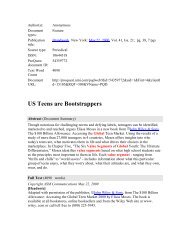

![Graduate Bulletin [PDF] - MFC home page - Appalachian State ...](https://img.yumpu.com/50706615/1/190x245/graduate-bulletin-pdf-mfc-home-page-appalachian-state-.jpg?quality=85)
